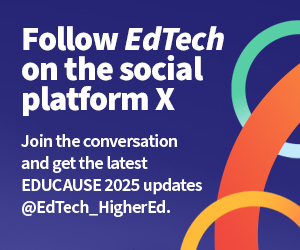He encouraged faculty to not demonize AI in the classroom because it will only be more relevant for students in the future.
“Let us celebrate the presence of AI in our world,” he said. “I think students are going to be great in teaching us the technical details. Let’s give them the gift of problems and questions and challenge them to use AI to solve them, and I think you’ll be shocked.”
David Seidl, vice president for IT and CIO at Miami University, said the real opportunity for AI growth in the classroom over the next decade will come from personalized learning. He asked attendees to think of a faculty member they had during their college education who was less than great.
“Would you prefer the best faculty member that money can buy?” he asked. “Or would you prefer that faculty member?”
DISCOVER: Modern learning environments improve student outcomes.
He noted that AI won’t make the in-person college experience obsolete, as the interpersonal connections are still a key part of higher education, but for students who need something different from their education, AI holds promise.
“For people who cannot easily access that quality of education, for people who are adding on additional learning or for people who learn differently than how a faculty member teaches, this will be transformative,” he said. “That’s where the infrastructure, the tooling and the will to do that is going to be changing, and we have to work to be competitive against that at our institutions.”
Flexible Workplaces Should Incorporate AI as a Partner
Students are only one part of the equation on college campuses. Technology is shaping how modern workplaces operate, and over the next decade, staff members’ lives are sure to change.
“Ten years from now, we will have had AI that has been online and working with you as a partner for a meaningful part of your professional career,” Seidl said. “Picture your favorite coworker and think about how helpful they can be because they know you that well. That’s exciting.”
LEARN MORE: Artificial intelligence is making modern workplaces more efficient.
Still, despite the change on the horizon, Seidl said, it’s important to keep people at the center of the conversation.
“How do we keep humanity in the cycle? Value what humans bring,” he said. “Be the irreplaceable component in that equation and then serve our institutions along the way.”
When it comes to educators and AI, Krishnamurthy said there are three different types of professors: Those who are in the loop, those who are on the loop and those who are out of the loop. The first are faculty members who are actively using AI in some capacity. The latter do not use it at all. The middle users — faculty on the loop — have the most potential to make waves.
“I think they are more interested in empowering students and providing feedback as they go through the experimentation process,” he said. “It could be a professor teaching an AI-infused pedagogy to assess where the students are and giving them some collective guidance from time to time or coaching them in a certain way.”
All institutions have faculty at each of these stages, he said, but the experimentation encouraged by this middle group should be celebrated.
UP NEXT: Universities help faculty incorporate AI into the classroom experience.
Higher Ed Leadership Will Have To Prove the Value of People
Moving forward, Krishnamurthy said, the struggle will be keeping up with the pace of innovation and educating students in a timely fashion. In an era where the value of a traditional college education is being called into question, ensuring the curriculum can keep up with the rate of technology evolution will be vital.
“We have to recognize that we are just a small part of the world that the students live in, and the students might very well be imagining ways to create outputs that have economic value,” he said. “How do we invite that innovation within our four walls, and how do we accommodate that innovation in a way that actually is supportive of the students work?”
As AI’s capabilities continue to grow, Seidl said, it will be important for leaders to show faculty and staff that their unique skills are valued.
“We always say to use AI if it’s better than the best person in the room, and that bar keeps lifting every few months,” he said. “From a human-centric moment, how do we continue to perceive our value in our organizations and how do we help our staff see their value in what they do over the next 10 years? That is going to be the thing that keeps me up for the next decade.”
Visit this page to catch up on all of our EDUCAUSE 2025 coverage, and follow us on the social platform X @EdTech_HigherEd for a behind-the-scenes look at our coverage.













